In Part 1 we looked at the official Western media narrative of the Syrian conflict. If we accepted this, then the U.S led coalition’s intervention can essentially be seen as a response to the circumstances of the Syrian conflict, all of which were beyond the control of the Western coalition. However, the evidence suggests this is very far from the truth. What it shows is that the recent attempt by the U.S led coalition to overthrow the Syrian Government of Bashar al Assad was yet another in a long line of foreign interventions within Syria. What’s more, the most recent attempt by the West appears to be part a concerted effort to destabilise the Middle East in support of both the geopolitical objectives of regional allies, most notably Israel, Saudi Arabia and Qatar, and the pursuit of global corporate profit.
Speaking in 2007, U.S. Army General Wesley Clark the former NATO Supreme Allied Commander in Europe (1997 to 2000) recounted a conversation he had with one of his former comrades in the Pentagon, shortly after the U.S. invasion of Afghanistan in 2001:
“About ten days after 9/11 I went through to the Pentagon. I saw Secretary Rumsfeld and Deputy Secretary Wolfowitz. I went downstairs just to say hello to some of the people on the joint staff who used to work for me.[and] One of the generals called me in and he said ‘Sir you’ve got to come in and talk to me for a second’ and I said no we can’t, we’re too busy and he said ‘no, no,’ he said ‘we’ve made the decision to go to war with Iraq.’
This was on or about the 20th of September [2001]. I said, we’re going to war with Iraq? Why? He said ‘I don’t know.’ He said ‘I guess they don’t know what else to do.’ So I said well, did they find some information connecting Saddam with al Qaeda? He said, ‘no, no there’s nothing new that way. They’ve just made the decision to go to war with Iraq.’ He said ‘I guess it’s like we don’t know what to do about terrorists but we’ve got a good military that can take down governments.’ [and] He said. ‘I guess if the only tool you’ve got is a hammer every problem has to look like a nail.’
So I came back to see him a few weeks later, and by that time we were bombing in Afghanistan, and I said to him are we still going to war with Iraq? [and] He said, ‘Oh it’s worse than that,’ he said. He reached over his desk and he picked up a piece of paper and he said, ‘I just got this down from upstairs,’ meaning the Secretary of Defence’ office ‘today’ and he said, ‘This is a memo that describes how we’re going to take out 7 countries in 5 years. Starting with Iraq and then Syria, Lebanon, Libya, Somalia, Sudan and finishing off Iran.’”
Then there are the words of former French Foreign Minister, Roland Dumas. When asked about the Syrian war he said this:
“I went to England almost two years before the start of hostilities in Syria. I was there by chance on another business, not at all for Syria. I met British officials, some of whom are friends of mine. They confessed, while trying to persuade me, that preparations for something were underway in Syria. This was in England, not in the U.S. Britain was preparing gunmen to invade Syria.
They even asked me, under the pretence that I was a former Foreign Minister, whether I wanted to participate in this. Of course I declined. I am French. I am not interested.
I just need to say this operation goes way back. It was prepared, conceived and planned…..Very simply for the purpose of overthrowing the Syrian government.”
These ‘crazy conspiracy theorists’ suggest the possibility that our intervention in Syria wasn’t in response to the violence. Far from a humanitarian rescue mission, it was planned in advance. Is their any evidence the main coalition protagonists, the U.S, UK, France, Turkey, Saudi Arabia and Qatar, were looking for a casus belli?

We already know the ‘colour revolutions’ of the ‘Arab spring’ were paid for by the National Endowment for Democracy (NED), among others. These uprisings were backed by major global corporations, with logistical support from Western NGO’s and U.S. government funded groups on the ground. As we have discussed elsewhere, this doesn’t mean the people swept up by these movements didn’t have legitimate concerns. It would be almost impossible to mobilise millions of people if they weren’t interested in the opportunity on offer.
In Syria there has been a political reform movement for many years. Their concerns are primarily about political corruption and the Ba’ath Party’s monopoly on power. The problems in Syria increased in 2006 when the International Monetary Fund (IMF) decided the Syrian’s required some ‘economic medicine.’ This included enforced austerity measures, a freeze on wages, the deregulation of the financial system, trade reform and privatization. Consequently, unemployment soared as Syria’s socialist economy deteriorated. This enforced deprivation accelerated, following the 2008 – 2010 banker bail outs which crippled economies the world over.
Syria certainly isn’t perfect and its human rights record, while far from the worst, isn’t good. The Syrian Government have been guilty of brutal oppression. However, it is the only remaining independent secular state in the Arab world. Unlike some other Arabic nations, its populist, anti-imperialist, secular and socialist Ba’ath Party has widespread majority support. Syria has a well-informed population who understand the external pressures placed upon their country. Al Assad faced a string of crisis in the first years of his presidency. The U.S.’ invasion of Iraq in 2003; the assassination of former Lebanese prime minister Rafiq Hariri and the concerted bid to force Syria out of Lebanon in 2004; Washington’s decision to break diplomatic relations with Damascus in 2005; Israel’s attack on Lebanon in 2006, its blockade of Palestine in 2007, and its bombing of Gaza in 2009 causing widespread demands for action in Syria.
In addition, Syria had faced repeated CIA and MI6 orchestrated coups throughout its history. From the 1949 overthrow of President Shukri al-Kuwatli through Operation Straggle, in 1956, and Operation Wappen, in 1957, and the Western backed Sunni militant protests in 1963. These frequent attempts to interfere in Syria’s internal politics culminated in the Hama ‘massacre’ in 1982. The Syrian Government, of Hafez al-Assad (Bashar’s father,) violently suppressed an alleged uprising, led by the Muslim Brotherhood. MSM estimates of those killed by the Syrian government vary from between 10,000 to 40,000. At the time, Syria was riven by terrorist attacks. The Al Taleea Al Muqatleh (the fighting Vanguard) were a Muslim Brotherhood backed Islamist terrorist group engaged in a bloody insurrection throughout Syria. For example, the 1975 Azbakiyeh Bombing in Damascus killed 175 people.
However, a declassified CIA intelligence documents revealed the ‘reports’ of mindless brutality by the Syrian government in Hama, may not have told the whole story. While still horrific, the death toll was estimated at less than 2000, according to the CIA. They stated that at least 400 of those killed were Al Taleea Al Muqatleh terrorists. Hama was a terrorist stronghold, and the Syrian government appeared to be trying to oust them from their territory. The Hama ‘massacre’ also killed hundreds of Syrian security force personnel suggesting a battle rather than a one sided slaughter. This in no way excuses the Syrian government’s shelling of civilian areas for nearly a month but, if the intention was to get rid of the terrorists who had killed thousands of Syrians, it worked. The Muslim Brotherhood were routed. The CIA memo stated:
“The Muslim Brotherhood leadership was fully aware that they had the Assad regime in a ‘no win’ situation over Hama. If Assad had not acted forcefully against Hama, the rebellion might have spread to other cities, which in turn might have led to a full-scale rebellion. Assad’s liberal use of artillery in breaking the resistance in Hama served notice to other cities that he has both the will and the means to retain power. By the same token, however, the government’s actions have appalled and sickened a wide spectrum of Syrian society. Nonetheless, Assad’s strategy continues to be based on the realization that most Syrians, regardless of their differences with the present government, do not want the Muslim Brotherhood in power, although they would undoubtedly prefer one dominated by Sunni Muslims [instead of Assad’s Alawite sect].”
At the time, the leading advocates for the Hama attack were Syrian Minister of Defence, Mustapha Tlass, and the Minister of Foreign Affairs, Abdul Halim Khaddam. The siege of Hama was led by Rifaat al Assad (Bashar’s uncle.) Today Riffaat, Mustapha and Abdul Halim are among the leading supporters of the supposed opposition against Bashar al Assad.
Muslim Brotherhood influence in Syria dwindled after the Hama atrocity. Their significant influence didn’t return until the so called Free Syrian Army was set up by the U.S. led coalition and its Gulf allies in 2011. The West’s covert relationship with the Muslim Brotherhood stems back to at least the 1950s. Former CIA operative Miles Copeland revealed the CIA cooperated with the Muslim Brotherhood to overthrow (or assassinate) President Nasser of Egypt. Nasser’s economic reforms threatened international bank and global corporate profits. Therefore, the CIA and MI6 worked with the Muslim Brotherhood to get rid of him.
In 1988 the al Taqwa bank was established in Switzerland. A key founder of the bank was a senior figure within the Muslim Brotherhood, Said Ramadan. The al Taqwa bank was a main funder of al Qaeda and many other Wahhabi terrorist groups, according to a 2002 U.S. Treasury Department report. The U.S. Treasury pressured the U.N to list the bank as terrorist financiers shortly after 9/11. Said Ramadan supported the Saudi’s to set up the Muslim World League in 1962. The League would also go on to fund al Qaeda and other terrorist groups. Said Ramadan was a likely Western intelligence asset with close ties to both the CIA and MI6. The U.N removed the al Taqwa bank from its list of al Qaeda financiers in 2010, less than a year before the start of the spontaneous ‘uprising’ in Syria.
The Muslim Brotherhood was outlawed in Syria and had no real presence in the country beyond the early 1980s. Membership was an offence punishable by the death penalty. In 2009, following the Israeli bombing of civilians in Gaza, the Brotherhood officially ended their opposition to the Syrian government. They ceased their support for the Syrian ‘president in exile’ Abdul Halim Khaddam who, as we have mentioned, was a key figures in the Hama seige. However, following a 2010 meeting in Antalya, Turkey, and another hastily arranged Islamist conference in Brussels, the Syrian opposition was formed with the Brotherhood at its core. While plagued with internal divisions, this nonetheless led to the creation of the Syrian National Council (SNC) in Doha, Qatar in 2012. The SNC attempted to bring all the anti Assad forces together under their banner.
The Muslim Brotherhood (MB) moved quickly to set up numerous groups within the SNC including the Syrian Arab Tribal Council and ‘the Revolution Council for Aleppo and Its Countryside,’ among many others. Other MB groups, not directly represented in the SNC, were created, such as the Syrian Human Rights Committee, which was led by the Syrian ‘opposition’s’ ambassador to Great Britain Walid Saffour (a prominent MB member.)
The MB initially failed to form alliances with defecting Syrian military officers. The so called ‘Free Officers’ were reluctant to accept their money or authority. After repeated attempts to win them over the MB abandoned that approach and instead split the Free Officer group. They offered financial backing to the minority who were willing to accept their leadership. This led to the formation of the Free Syrian Army (FSA) headed by Colonel Riad Al Asaad, under the authority of the Muslim Brotherhood.
The vast majority of the Syrian people despise the MB for obvious, historical reasons and have a general loathing of their archaic, regressive theological philosophy. The FSA was widely touted in the Western MSM as the face of the ‘moderate rebels.’ Certainly, compared to the Islamist terrorists who would soon take over the insurgency, they were less fanatical. The MSM told us they were fighting for the freedom of the Syrian people. Seeing as the FSA was predominantly created and backed by the Muslim Brotherhood, the Syrian people overwhelmingly rejected it from day one.
The brief period of popular support among poorer Syrian communities and students rapidly dissipated as the violence of the ‘uprising’ repulsed ordinary Syrians. In response to dwindling popular support, the FSA hastily established the Supreme Military Council (SMC) as a moderate ‘alternative’ to the Islamist brigades. This had virtually no effect on the ground as the Islamist extremists took up the banner of the Islamic Front and abandoned the remnants of the FSA. It was really only the Western MSM and the politicians who persisted with the FSA ‘moderate rebel’ story. It allowed them to claim legitimacy for the arms shipments to the terrorists. Plausible deniability.
Plagued by internal squabbles, the Syrian National Council also fell apart in 2013 and the U.S. coalition withdrew its recognition of their legitimacy. U.S. Secretary of State Hillary Clinton stated the U.S. no longer considered the SNC to be “the visible leader of the opposition” and that a new opposition group was required to represent “those who are in the front lines, fighting and dying today to obtain their freedom.” We might ask who required a ‘new opposition group.’ It didn’t appear to be the Syrian people.
Earlier in 2012, senior neocon Senate leaders like Sen. John McCain and Sen. Lindsay Graham were calling for the arming of the ‘moderate rebels.’ They were supported by their equally ‘hawkish’ allies in Britain like British Foreign Secretary William Hague, who declared that British Government now recognised the legitimacy of the newly formed ‘National Coalition of the Syrian Revolutionary and Opposition Forces,’ also known as the Syrian National Coalition. Seeing as its forerunner, the ‘Council,’ was largely cobbled together by the despised Muslim Brotherhood what popular support did the Syrian National Coalition have? How many Syrian people chose them as their leaders to oppose the evil dictator Bashar al Assad?
Firstly the ‘Coalition’ contained many of the same faces from the SNC. These included the SNC’s former president George Sabra who was appointed by a group of 28 Qatari based Syrian exiles. The new ‘Coalition’ president was Khaled Khoja, empowered by 56 Syrian exiles living in Turkey. Similarly, Ahmed Jarba got his ‘legitimacy’ from 65 of the same Turkish residents.
When Bashar al Assad inherited power in Syria in 2000, it was as a reformer. Bashar was thrust into the role after the death of his older brother Bassel in 1994. Up to that point he was quietly pursuing his medical career. He immediately faced problems. On the one hand the people were increasingly demanding political and economic reform. His promise to deliver it undoubtedly led to his 97% referendum result during the leader selection process. However, he was also expected by the Ba’ath Party to continue the pluralism and nationalism of his father.
While his fathers rule was single party, authoritarian and oppressive, Hafez al Assad also brought stability following the repeated foreign sponsored coup attempts. Infant and maternal mortality drastically declined, and an extensive infrastructure program greatly benefited rural Syrian communities. When his modern, Western educated, young son came to power hopes were high that greater reform was on the way.
There was a significant anti Ba’ath Party movement in Syria, but it was fragmented. The Islamist element wanted to establish a theocracy while the larger majority, who were vehemently opposed to a theocracy, wanted economic and political reform. Despite the hopes, the political reforms didn’t materialise. However, Bashar al Assad did improve education and liberalised the economy without the necessity for widespread privatisation. He led improvements to the free health care and education systems and continued to invest in Syrian infrastructure projects. He liberalised access to information, allowing Syrians to access the internet. However, this was still monitored and regulated. The feared secret police, the Mukhabarat, continued to detain and imprison people through a kangaroo court system, and widespread allegations of torture persisted under Bashar al Assad’s presidency.
In 2003, the Iraq War saw more than a million Iraqi’s flee to Syria. With a modest GDP, Syria still welcomed the refugees but the U.S. administration accused them of backing the Iraqi resistance and imposed economic sanctions at the worst possible moment. The genuine Syrian opposition briefly found common ground, following Syria’s withdrawal from Lebanon in 2005. This resulted in the ‘Damascus Declaration’ which called for the abolition of martial law and the ‘special courts,’ increased freedom for trade unions, political and religious groups; it also demanded the re-establishment of military protection for Lebanon, increased investment in the Syrian Arab Army (SAA) and stated the Syrian people rejected “change that is brought in from abroad.”
The opening statement of the declaration included direct criticism of the Ba’athist’s rule:
“The authoritie’s monopoly of everything for more than 30 years has established an authoritarian, totalitarian and cliquish regime that has led to a lack of interest in politics in society, with people losing interest in public affairs”
However, the divisions within the opposition soon resurfaced as the Marxist left bitterly disagreed with the Islamist right. Sectarian and nationalist divisions also caused disunity. Assad’s government capitalised on the breakdown and a number of signatories were arrested while U.S. backed Syrian media organisations had their broadcast licences revoked.
If Syrians and other people across the Middle East are united upon anything it is Arab nationalism and regional unity. A 2009 poll of 6 nations showed that it was the U.S. and Israel who were seen as the greatest threat by more than 75% of the population. Bashar al Assad was the most popular of all Arab leaders. Given U.S. history in the region, there is no doubt that most Syrians were strongly opposed to the Washington administration.
Regardless of Western coercion, the Arab Spring uprisings in Tunisia and Egypt had genuine mass appeal. This was not entirely the case in Syria. Even so, in response, Assad stated that he would increase the pace of reform. Syria was a very different nation from either Tunisia or Egypt. The Syrian government had promoted social and educational development, minority rights were protected and Syria’s foreign policy was not determined by either the U.S. or Israel. However, most importantly, it had little external debt. It didn’t owe the global banking cartels much at all. Something they weren’t keen to see continue.
Following the protests and the start of the violence in Daraa, huge pro government rallies were held in Damascus and Aleppo. There is no evidence that these were in any way ‘forced.’ Obviously the Syrian government were more than happy to let them proceed, but the groundswell of support for the Syrian government by its people was genuine. Syrians have a strong sense of national identity forged by years of antagonistic foreign interventions.[211]
One of the few Western MSM journalists who actually went to Syria was Robert Fisk. He is certainly no Assad apologist, having harshly criticised the Syrian government for many years. In reference to the pro government rallies, in 2011 he wrote:
“Another pro-Assad rally was starting … it might have reached 200,000 by midday … there was no Saddam style trucking of the people to Omayad Square [Damascus] … the only soldiers were standing with their families. How does one report a pro-government demo during the Arab Awakening? There were veiled women, old men, thousands of children … were they coerced? I don’t think so”
A 2012 poll carried out by the Qatari financed ‘Doha Debates‘ TV program had to reluctantly admit in 2012 that 55% of the Syrian people wanted Bashar al Assad to remain in power. The fact was that Syrians understood that Bashar al Assad faced opposition within the Ba’ath Party from, what was perceived to be, the ‘old guard.’ He had failed to introduce significant political reform but he had done enough to convince them, with economic reform and a liberalisation agenda, that he represented their best chance. What they didn’t want, beyond all else, was a Muslim Brotherhood inspired Islamist theocracy. Especially Syria’s women, Ghaidaa Hetou wrote:
“The roots of the Syrian president’s popularity among large segments of the Syrian populations stem from the above mentioned policies [economic reform, liberalisation & foreign policy independence.] When Bashar al Assad says that he supports political reform, many Syrians believe him … Syrians in recent years have enjoyed greater religious freedoms, which includes the Sunni majority.”
The U.S. puppet governments in exile, represented by the failed SNC and later the Syria National Coalition, were largely treated with derision in Syria. Syria had an opposition of sorts. The Syrian Social Nationalist Party (SSNP) had gained seats in the Syrian Parliament in 2005. While some distance away from forming a genuine democratic opposition, they did see themselves as reformists and had popular support in Syria as a result. They didn’t want to see Syria destroyed either. Speaking in 2011 SSNP Vice President for Syria, Safawan Salman, said:
“We are simultaneously with the stability of the Syrian state and the cohesion of Syrian society, and with profound and extensive reforms. We believe that the stability of Syrian society is necessary for the reforms to succeed”
They would not have been allowed to take their seats without agreeing to Syrian national unity but that doesn’t mean the belief wasn’t genuine. The SSNP were critical of the Syrian elections in 2012 and the subsequent government. However, continuing with the reform process, the 2012 Syrian cabinet included members from other parties. For example, SSNP President Ali Haidar accepting the appointment by President Assad to be the Syrian Minister for Reconciliation.
The low point for Assad’s domestic popularity appeared to be in 2011 when he was widely blamed for the violence that had erupted across the country. By no means was he perceived as a ‘butcher’ or ‘murderous tyrant.’ Many Syrians thought he was being too soft on the terrorists. His Syrian nickname was ‘Mr Soft Heart.’ However, as the insurgency intensified the besieged Syrian people rallied around their army, their nation and their leader, probably in that order. Continuing Assad’s reforms, in 2014 Syria held a contested presidential election for the first time in decades. Already popular, and with total control over the mechanisms of state and most of the media, Bashar al Assad undoubtedly had an unfair advantage.
However, three candidates stood for the presidency. Bashar al Assad, Hassan al-Nouri (a former Assad government minister) and Aleppo Communist MP Maher Hajjar. They differed on economic and constitutional reform issues, but they all agreed that Syria should remain a whole nation state and that the Syrian Arab Army (SAA) needed support in the struggle against terrorism. Voter turn out was high, at 73%. 10.3 Million people, representing 64% of entire electorate, elected Bashar al Assad as their president. The U.S. led coalition scoffed at the result, claiming it was a fix. The Western MSM made false allegations that the Syrian ‘regime’ wouldn’t allow ‘real’ international election observers and the election was a farce. This was a lie, more fake news.
The western MSM leveled the ridiculous allegation that their were no polling booths in ‘opposition held territory.’ They neglected to explain how the Syrian government might work with al Qaeda, Kurdish seperatists and ISIS to run open and free elections in the their territory. Regardless of the moronic allegations of the western MSM, over 100 international observers attested to the legitimacy of the election result, it’s just that they weren’t the hand picked observers the U.S led coalition would have preferred.
The Syrian people have a close relationship with their military. With nearly 500,000 troops, the SAA represents every community in Syria. Sunni, Alawi, Shi’iah, Christian, Druze, Kurd, Armenian, Assyrian, and other sections of society are all brought together in the military. They all recognise the secular state and overwhelmingly unite as Syrians. There are very few places in Syria where there isn’t a local military presence. The army are treated with gratitude and respect and millions of Syrians have personal, family connections to them. This makes it very difficult to believe all the allegations of atrocities committed by the SAA against the civilian population. In particular there are immense evidential problems with the alleged chemical weapons attacks supposedly perpetrated by the SAA. In many respects the SAA are the Syrian people. We have perhaps too easily believed these allegations without any real evidence.
The Western MSM describe the Syrian Arab Army as ‘Assad loyalists.’ This is like calling the U.S. army ‘Trump loyalists,’ a petty attempt to suggest divisions that don’t exist. However, it is technically correct, though their loyalties are more to the Syrian people and the nation rather than its President. Much was made of the thousands of deserters determined to oppose the despotic Syrian leader. We were told they were joining the ‘revolution’ to fight for democracy and freedom. However, the desertions were never in any great number. Before the FSA’s total collapse, even the anti Assad ‘Syrian Observatory on Human Rights’ openly admitted that less than 1000 of the estimated half a million SAA soldiers had joined the FSA. This is 0.2% of the army, hardly a revolution.
Bashar al Assad is a politician. Of course he exploited nationalism for his own and his Party’s gain, what politician wouldn’t given the opportunity? However, the tale spun about ‘the despised Assad Regime’ and the impression we have been given simply is not born out by the evidence. It is ‘fake news.’
The Western MSM vilification of the ‘regime’ is the epitome of a coordinated propaganda campaign. The perpetual use of the word ‘regime’ has been used to brainwash the public. It’s a ploy to make us all believe Assad is universally hated in Syria. He isn’t. He is the current elected President of Syria and leader of the Syrian Government with a mandate that far exceeds that of the U.S. President or the British Prime Minister. It should be noted that, in the case of Theresa May, her government is only in power thanks to a £1 billion bribe her party paid from the public purse to the Democratic Unionist Party who have numerous historical links to loyalist terrorist organisations. Perhaps the Syrian people will want to rid themselves of Bashar al Assad eventually, but that must be a decision for the Syrians, not the U.S. led coalition or the Wahhabists.
This is the political reality within Syria. Bashar al Assad is not universally despised by the Syrian people, as we have been led to believe. He won an overwhelming mandate from the Syrian electorate to rule in 2014 in an election which did meet the required international standards for openness and fairness and was independently verified. The image we have been force fed by the Western MSM that Assad is nothing but a murderous tyrant is an abject, miserable deception. Nothing more than propaganda.
This is not to suggest that all is well within Syrian politics. There are genuine calls for reform, the Syrian Government have oppressed the population at times and have stifled freedom of speech and political diversity. However the historical context, set against the backdrop of repeated foreign interventions, coup attempts and concerted efforts to destabalise both the economy and government, is complex. Bashar al Assad is seen by many Syrians as their best hope for genuine progress. He has brought about significant liberal and economic reform, sought to bolster political freedoms and freedom of information in Syria.
However, Western propagandist disinformation about the Syrian political landscape is perhaps eclipsed by the total lie we have been told about the so called Syrian ‘civil war’ which was neither Syrian nor a civil war. In Part 3 will discuss how the conflict within Syria actually unfolded, who the main players were and why we have been systematically deceived about the nature of the conflict by our own, so called, free press.




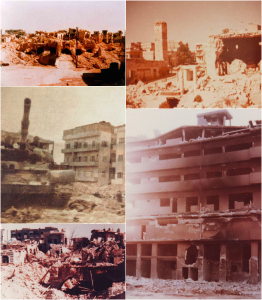
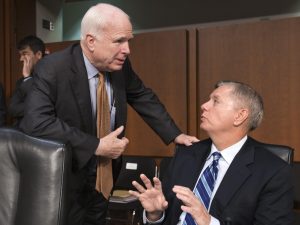
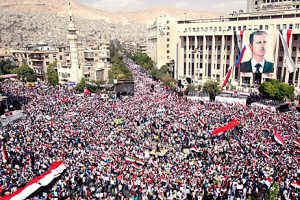
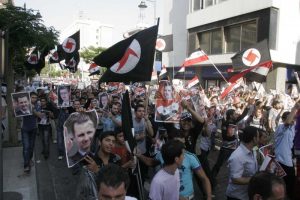

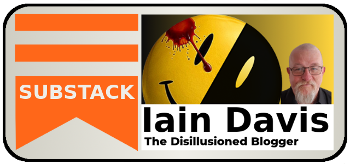





Be the first to comment on "The Syrian Conflict Deception – Part 2"